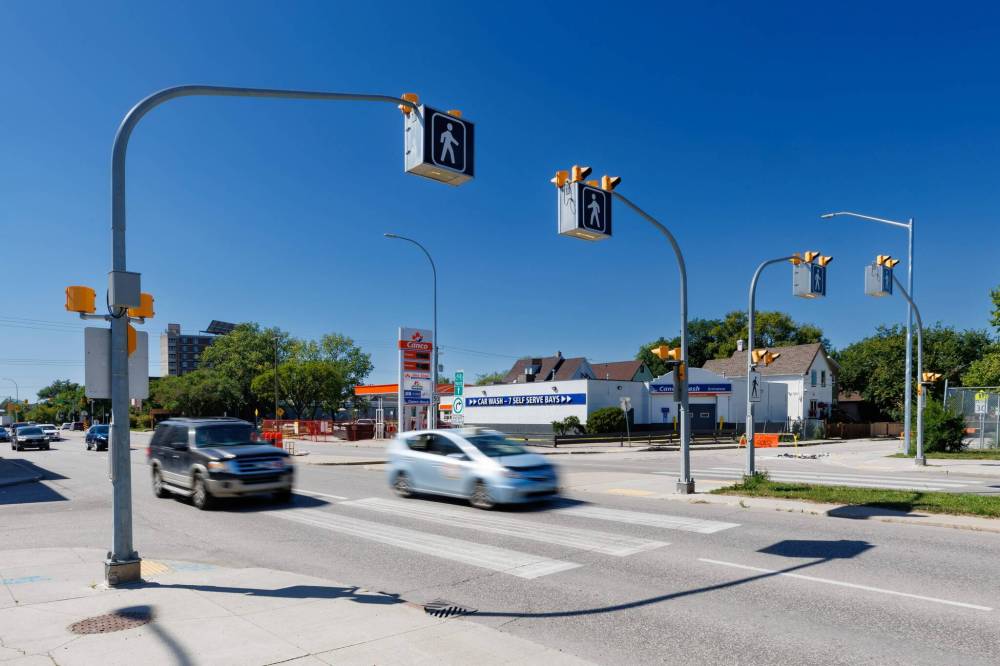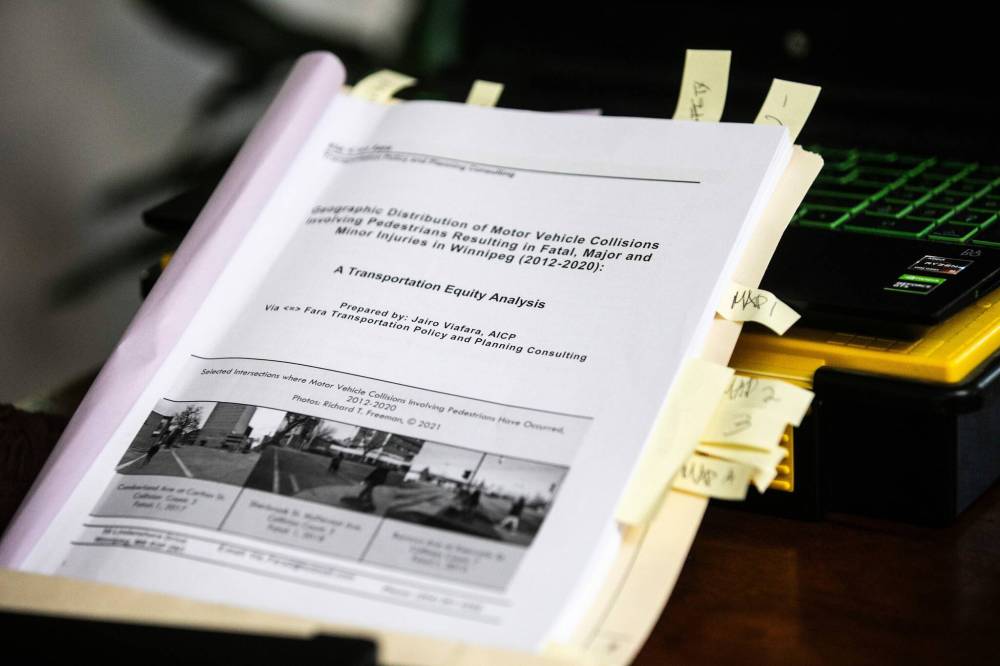The City of Winnipeg is being urged to ramp up road safety in central neighbourhood intersections, where a report finds pedestrians have been more at risk of getting injured or killed in collisions.
The planning consultant’s report on intersection collision data from 2012 to 2020 found 44.9 per cent of 39 fatal pedestrian-vehicle crashes at intersections were located within or near the city centre or downtown.
“Most fatalities happen in the same areas around downtown or in the neighbourhoods surrounding downtown, like Point Douglas or West Alexander … but also most prominently around (the Winnipeg) School Division. If we pay attention to those areas, in my opinion, it’s a good beginning for us to start (making streets safer),” Jairo Viafara, who wrote the report, said.

MIKAELA MACKENZIE / FREE PRESS
Planning consultant Jairo Viafara shares his report on intersection collision data.
His transportation equity analysis focused specifically on crashes that took place at intersections, for which the most specific geographic data is available.
Viafara found 1,118 (61.3 per cent) of the 1,822 pedestrian-vehicle crashes that caused major and minor injuries took place within the catchment area of the school division. About one-third of the fatal pedestrian collisions he studied took place in the downtown east, downtown west, North Point Douglas and South Point Douglas areas, he said.
“In certain neighbourhoods, residents continue experiencing a persistent lack of safe pedestrian facilities,” he wrote in the report.
Viafara suggests a lack of progress to improve the most collision-prone intersections “may indicate to the public that pedestrian safety is not being considered a priority concern by local decision-makers.”
The head of a local residents committee said she’s seen several road safety hazards in her neighbourhood.
“I’ve wanted to go walk my dog around the Louise Bridge. It’s impossible to get across there safely … You just take your life in your hands and run,” Catherine Flynn, chairwoman of the Point Douglas Residents Committee, said.
Flynn said there are also too few controlled crossings to help pedestrians cross key sections of Main Street and Higgins Avenue, where many folks jaywalk.
“I’m not an urban planner, but I think when you’ve got a city that (can get) so cold, one of the things you’ve got to think of is what is the number of safe crossings … It could be -30, -40, windy … of course (pedestrians are) going to run across the street (wherever they are),” she said.
Viafara said the affected neighbourhoods appear more likely to rely on walking to get around. Many of the residents have lower incomes than other Winnipeggers, he said.

MIKE DEAL / FREE PRESS
The crosswalk at Isabel Street and Alexander Avenue. Viafara is urging the city to make several changes to make core-area intersections safer.
“So, there is a connection between … fatalities and traffic accidents involving people of low income,” Viafara said, noting that appears to be common across Canada.
Coun. Janice Lukes, chairwoman of council’s public works committee, is calling for city traffic experts to review the report.
“The city does know that there are a lot of collisions in the downtown because anywhere where there’s more density, there’s more collisions … It’s (about) putting the spotlight on the vulnerable road user.”
The Waverley West councillor said the city has four staff members devoted to implementing a road safety action plan, who prioritize new projects using an “equity lens.”
“It’s a huge pillar in what we do,” Lukes said.
The city expects to spend $30 million on road safety improvements over the next six years, she said.
Viafara is urging the city to make several changes to make core-area intersections safer. The recommendations include prioritizing pedestrian safety countermeasures for downtown and adjacent neighbourhoods, conducting “walkability assessments” near frequent collision sites, improving collision data collection and preparing safe route to school plans.
He said countermeasures could include adding lights, medians and other road treatments to help minimize the risk of crashes.
“Transportation (needs) to be part of the revitalization effort,” Viafara said.

MIKAELA MACKENZIE / FREE PRESS
Coun. Janice Lukes, chairwoman of council’s public works committee, is calling for city traffic experts to review the report.
While the number of fatal pedestrian-vehicle crashes decreased from 15 in 2019 to seven in 2020, Viafara said five-year averages are considered more statistically significant, so conclusions shouldn’t be drawn from that limited data.
“Based on the five-year (data), the numbers are steadily increasing,” he said.
Viafara found pedestrian collisions resulting in fatal injuries increase by 25 per cent and pedestrian collisions resulting in injuries increased by 39.9 per cent between 2012 to 2016 and 2016 to 2020.
joyanne.pursaga@freepress.mb.ca
X: @joyanne_pursaga

Joyanne Pursaga
Reporter
Joyanne is city hall reporter for the Winnipeg Free Press. A reporter since 2004, she began covering politics exclusively in 2012, writing on city hall and the Manitoba Legislature for the Winnipeg Sun before joining the Free Press in early 2020. Read more about Joyanne.
Every piece of reporting Joyanne produces is reviewed by an editing team before it is posted online or published in print — part of the Free Press‘s tradition, since 1872, of producing reliable independent journalism. Read more about Free Press’s history and mandate, and learn how our newsroom operates.
Our newsroom depends on a growing audience of readers to power our journalism. If you are not a paid reader, please consider becoming a subscriber.
Our newsroom depends on its audience of readers to power our journalism. Thank you for your support.